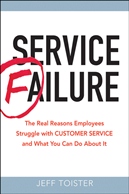Why your customers often see what you don't
 Jeff Toister
Jeff Toister  Wednesday, March 6, 2013 at 5:37AM |
Wednesday, March 6, 2013 at 5:37AM | The classic nine dot puzzle is one of my favorite customer service training exercises. Give the puzzle a try if you haven’t seen it before:
- Connect all nine dots using four straight lines
- You cannot lift your finger off the screen (or, if you prefer, your pen off the paper)

Why is the puzzle so hard for most of us to solve?
The secret is our instincts affect how we view potential solutions. Most of us see a box that doesn’t exist. As a result, we try to solve the puzzle by staying within the box. (See the bottom of the post for the solution.)
It’s a useful training exercise because it helps customer service professionals realize that we tend to see the service we provide through a certain frame. The trouble is customers view our service through their own frame and their frame is frequently different than ours.
Last week, I wrote about an experience where two employees took very different approaches to replacing a disappointing bottle of wine. The two employees each had their own way of framing the problem. The first employee looked at the problem as a bottle of wine that needed to be exchanged. The second employee looked at the problem as a customer who was disappointed with their product.
As you can imagine, I was much happier with the service I received from the second employee since her frame was the same as mine.
Adopting the customer’s perspective is not always easy. It sounds great in theory, but it is much more difficult in practice. Chalk this up to the Dunning Kruger Effect, a phenomenon I recently wrote about by comparing customer service to professional baseball.
There are a few ways you can help your employees change their frame and see things from the customer’s point of view:
- Create a Customer Service Vision that defines outstanding service
- Have your employees use your product or service and evaluate their experience as a customer.
- Review customer feedback to understand what drives satisfaction and dissatisfaction.
Are you still trying to solve the puzzle? You can view this short video to see the answer.





